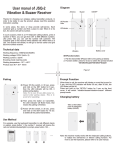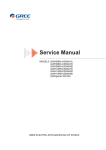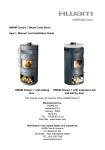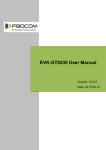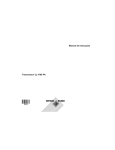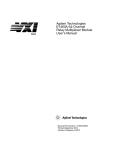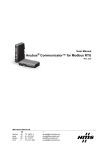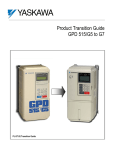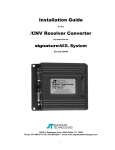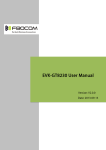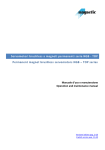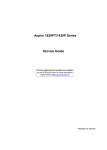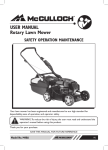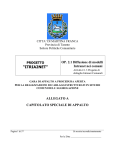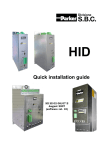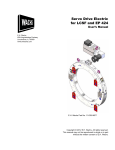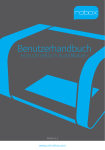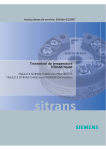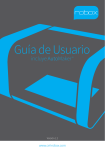Download spimd20 - STMicroelectronics
Transcript
SPIMD20 Integrated motor drive Datasheet — production data Features ■ Advanced brushless motor control in a single module easy to piggyback to the motor ■ Extremely compact dimensions: 165x60x26 mm, <0.5 kg weight ■ Up to 2 kW power with 800 Vdc supply, on 100°C motor surface, can withstand peak of current up to 40 A ■ Can operate on a motor surface temperature up to 100°C ■ Integrated drive with real time connectivity via Ethernet-based fieldbus (i.e. EtherCAT®) and CANopen® DS402 ■ Safe torque off to disable IGBT drivers via hardware ■ CAN bus hand-shaking channel ■ RS232 interface for programming ■ 2 Mb Flash memory aboard; also support removable Flash memory card. ■ Supports position feedback both with resolver or digital encoder EnDat 2.2 ■ Motor current sensing with shunt sensors (2 phases) ■ Vibration analysis and thermal sensing ■ IP65 compliant ■ Safe architecture to apply to most popular safety standards IEC61800-5-1 ■ EMI: IEC61800 - 3 / A11 and UL508C ■ Up to 800 VDC supply, auxiliary supply 18-48 VDC ■ RoHS compliant SPIMD20 This Shuttle version of the IMD is suitable for direct integration to the permanent magnet synchronous motor (i.e. 6 Nm torque) thanks to the reduced dimensions 165x60x26 mm. The Shuttle Drive™ is designed to operate on a motor with a surface temperature up to 100 °C. The IMD performs all motor driving required functions including speed, position and current loop execution, plus connectivity. Connection to the master is performed via real time ethernet fieldbus, including but not limited to EtherCAT® as per IEC61158. However, the IMD is an open and flexible platform to execute any other communication standard with the aboard FPGA (Altera Cyclone III type) and the two microprocessors STM32F103 series. A basic software package is available with SPIMD20. This software package includes PWM driving, current loop and speed loop execution; all the above being synchronized to the fieldbus. Table 1. Device summary Order code SPIMD20 Description SPIMD20 is an integrated motor drive with real time connectivity enabling brushless motor manufacturers to create a proprietary motion control system based on a general purpose brick. July 2012 This is information on a product in full production. Doc ID 17527 Rev 3 1/20 www.st.com 20 Contents SPIMD20 Contents 1 2 Main features . . . . . . . . . . . . . . . . . . . . . . . . . . . . . . . . . . . . . . . . . . . . . . . 3 1.1 Block diagram . . . . . . . . . . . . . . . . . . . . . . . . . . . . . . . . . . . . . . . . . . . . . . . 5 1.2 Safe torque off diagram . . . . . . . . . . . . . . . . . . . . . . . . . . . . . . . . . . . . . . . 6 General specifications . . . . . . . . . . . . . . . . . . . . . . . . . . . . . . . . . . . . . . . 7 2.1 Ambient conditions . . . . . . . . . . . . . . . . . . . . . . . . . . . . . . . . . . . . . . . . . . . 7 2.2 Vibrations and shocks . . . . . . . . . . . . . . . . . . . . . . . . . . . . . . . . . . . . . . . . 7 3 Pin out description . . . . . . . . . . . . . . . . . . . . . . . . . . . . . . . . . . . . . . . . . . 8 4 Electrical characteristics . . . . . . . . . . . . . . . . . . . . . . . . . . . . . . . . . . . . 12 5 4.1 Absolute maximum ratings . . . . . . . . . . . . . . . . . . . . . . . . . . . . . . . . . . . . 12 4.2 Electrical data . . . . . . . . . . . . . . . . . . . . . . . . . . . . . . . . . . . . . . . . . . . . . . 12 4.2.1 Power supply . . . . . . . . . . . . . . . . . . . . . . . . . . . . . . . . . . . . . . . . . . . . . 12 4.2.2 Power stage . . . . . . . . . . . . . . . . . . . . . . . . . . . . . . . . . . . . . . . . . . . . . . 13 Mechanical dimensions . . . . . . . . . . . . . . . . . . . . . . . . . . . . . . . . . . . . . 15 5.1 Mechanical data (dimensions in mm) . . . . . . . . . . . . . . . . . . . . . . . . . . . . 15 5.1.1 6 2/20 Technical specifications for surface coupling . . . . . . . . . . . . . . . . . . . . . 17 5.2 The basic software package . . . . . . . . . . . . . . . . . . . . . . . . . . . . . . . . . . . 17 5.3 Safety characteristics and connection requirements . . . . . . . . . . . . . . . . 18 5.4 Installation and user's manual . . . . . . . . . . . . . . . . . . . . . . . . . . . . . . . . . 18 5.5 Maintenance . . . . . . . . . . . . . . . . . . . . . . . . . . . . . . . . . . . . . . . . . . . . . . . 18 Revision history . . . . . . . . . . . . . . . . . . . . . . . . . . . . . . . . . . . . . . . . . . . 19 Doc ID 17527 Rev 3 SPIMD20 1 Main features Main features The SPIMD20 is the top level performing power drive system designed by STMicroelectronics in cooperation with ROBOX S.p.A. Coming in a very compact size and operating at very high temperature, the SPIMD20 is ideal for direct installation on a permanent magnet synchronous motor or nearby the motor. The advantages of this system architecture are many, among them: ● SPIMD20 directly assembled to the motor permits a strong wiring reduction. The SPIMD20 just needs a DC power supply, a DC auxiliary supply, a fieldbus. All these connections can jump from one device to the other. The electrical cabinet will therefore result very compact. ● The distributed architecture allows faster designing and faster commissioning. ● The DC power supply shared between many SPIMD20s permits to realize sensible energy saving in a lot of applications. ● The fieldbus, Ethernet real-time, permits to make profit of all the advantages of flexible automation such as: recipes, fast switching among different previously saved menus, in-line behaviour optimization, centralized diagnostic and data logging. CANopen is optionally available in the development roadmap. ● A high performance FPGA Altera Cyclon III is available in the SPIMD20 to configure, among others, the Ethernet real-time bus according to your needs or preferences. The basic pack includes EtherCAT. ● Position read-out can be realized using the very popular resolver or other more performing devices such as EnDat 2.2 which are interfaced through the high performance FPGA. Different position transducers can be connected using their IP’s. ● PWM driving is organized for operation at 4-8-16-32 kHz. All the devices connected to the same master are synchronized to the driving fieldbus. The synchronization involves position, speed, current loops and the PWM. ● A MEMS accelerometer permits to analyze the vibrations: abnormal behavior can be detected before a fatal crash occur ● An SPI channel is available to support a compact flash or similar device in order to store parameters, programs or other tools depending on the application. Doc ID 17527 Rev 3 3/20 Main features ● ● SPIMD20 A basic software package is available with the SPIMD20. This software package includes: – torque speed position control – PWM driving 4-8-16-32 kHz – current loop closure 4-8-16 kHz (PI) – speed loop closure 1-2 kHz (PI) – position loop closure 1-2 kHz (P) – torque, speed, feed forward inputs provided – low pass or/and notch filters provided – All the above are synchronized to the fieldbus – Position transducers: resolver or encoder EnDat 2.2 – EtherCat connectivity (CoE DSP402) – CANopen (DS301, DSP402) is also in the development roadmap Two powerful development environments are available: – IAR’s Embedded WorkBench to work at source code level (C, C++) – Robox’s RDE to work at system level, permitting debugging and performance optimization under real operating conditions. A third one, QUARTUS II Altera development environment, should be used to implement other real time Ethernet standards or other digital transducers into the FPGA. 4/20 Doc ID 17527 Rev 3 SPIMD20 1.1 Main features Block diagram Figure 1. Block diagram )LHOGEXV &$1%XV )ODVK 0HPRU\ &$1%XV 5HVROYHU ELW 0,, 3+< )LHOGEXV (WKHUQHW ),(/'%86 SURFHVVRU +ROGLQJ %UDNH +ROGLQJ %UDNH 0,, 3+< )3*$ (1&2'(5 (Q'DW +DQG 6KDNLQJ %XV ELW '5,9( SURFHVVRU 9'& (QDEOH8SSHU &$1%XV 3RZHU 6WDJH %UXVKOHVV 0RWRU 9'& 3RZHU6XSSO\ Doc ID 17527 Rev 3 5/20 Main features 1.2 SPIMD20 Safe torque off diagram The module is equipped with four pins, available at JU1 and JU2 connectors, aimed to disable the IGBT drivers via hardware. The schematic architecture is showed in Figure 2. Once the pins 7 of JU1 and JU2 are respectively let opened versus the pins 8 of JU1 and JU2, the IGBT drivers are disabled. If the pin 7 is shorted with the pin 8 on both the connectors JU1 and JU2, the module is properly working. The current flowing on those connections is less than 5 mA. Figure 2. 6/20 Safe torque off diagram Doc ID 17527 Rev 3 SPIMD20 General specifications 2 General specifications 2.1 Ambient conditions Table 2. Ambient conditions operation (Ambient) 0 … +40°C operation (Motor) 0 … +100°C operation (Bottom Heatsink) 0 … +100°C operation (Top Heatsink) 0 … +70°C storage -30 … +70°C transportation -25 … +70°C operation 5 … 95% (1) storage 5 … 95% (1) transportation 5 … 95% (1) Temperature Relative humidity Altitude 4000mt Protection degree IP 65 & IP 67 1. Without ice and condensation 2.2 Vibrations and shocks Table 3. Vibrations and shocks Description Test conditions Value Unit Vibration sine: amplitude peak-peak 10…57Hz conforming to EN/IEC 60068-2-36 0.15 +/-15% mm Vibration sine: acceleration 57…150Hz conforming to EN/IEC 60068-2-6 1 +/-15% g Frequency 20 … 150 Hz 0,005 ±3dB g2/Hz 0.75 mm 5 g Vibration noise (random) IEC 68-2-36 Vibration sine according to EN 60068-2-6 and EN 60068-2-37 Spectral acceleration density, amplitude 10 … 2000Hz amplitude peak-peak Acceleration at 10 … 2000Hz Doc ID 17527 Rev 3 7/20 Pin out description SPIMD20 3 Pin out description Table 4. Pin description JU1/JU2 Name JU1 JU2 Type Description 1 1 2 - 3 3 4 4 POW_OK - 2 IO_24V 5 - IO_GND 6 - INP1 - 5 INP-24V INP2 - 6 INP-24V 3.3V_UP_O 7 - 3.3V_UP_I 8 - 3.3V_DOWN_O - 7 3.3V_DOWN_I - 8 ETH1_TXD+ 9 - ETH1_TXD- 10 - ETH1_RXD+ 11 - ETH1_RXD- 12 - ETH2_TXD+ 13 - ETH2_TXD- 14 - ETH2_RXD+ 15 - ETH2_RXD- 16 - CANH - 9 CANL - 10 CAN_GND - 11 SB_GND - 12 SB+ - 13 SB- - 14 HBR_RLS# - 15 INP-OD-3V3 Holding brake release PB# - 16 INP-OD-3V3 User push-button INP-OD-3V3 Connect to GND to enable boot from external flash memory (type M25P16). External flash have to be connected to CRD_pins. (see next page) leave pin EXT_FLASH floating to enable boot from internal flash memory. PS_AUX+ Power in Auxiliary input voltage 18 to 48Vdc INP-48V Input power OK, PS_AUX- referred PS_AUX- Power out 24Vdc digital inputs feeding Dig. inputs, 24Vdc, IO_GND referred EXT_FLASH# 8/20 - 17 Disable the IGBT drivers via hardware. If the pin 7 is shorted with the Safe torque off pin 8 on both the connectors JU1 and JU2, the module is properly working Ethernet CH1 ethernet 10/100 IEEE 802.3 Ethernet CH2 ethernet 10/100 IEEE 802.3 CanBus Fieldbus CAN CanBus Service bus Doc ID 17527 Rev 3 SPIMD20 Table 4. Pin out description Pin description JU1/JU2 (continued) Name JU1 JU2 Type LED1# 17 - OUT-LO-3V3 LED2# 18 - OUT-LO-3V3 WS_SDA - 18 BIDIR-3V3 WS_SCL 19 - OUT-3V3 JTMS 20 - INP-3V3 JTCK 21 - INP-3V3 JTDI 22 - INP-3V3 JTDO 23 - OUT-3V3 JTRST# 24 - INP-LO-3V3 JRESET# 25 - INP-OD-3V3 IO3# - 19 IO4# - 20 3V3 - 21 GND - 22 CRD_CS# - 23 OUT-LO-3V3 CRD_CLK - 24 OUT-3V3 CRD_DI - 25 OUT-3V3 CRD_DO - 26 INP-3V3 CRD_VCC - 27 CRD_GND - 28 RS232_GND 26 - RS232_RXD 27 - RS232_TXD 28 - Description User Led I2C line for WorkStation connection JTAG software debug port BIDIR-OD-3V3 TTL digital I/O, GND referred BIDIR-OD-3V3 External decoupling required Power out 3.3V power supply for outputs, LED and I2C - 100mA max 3.3V external flash. SPI Interface 50mA max. Power out RS232 RS232 full duplex connection ● INP-48 V: 48 V digital input, active high ● INP-24 V: 24 V digital input, active high ● INP-3V3: 3.3 V digital input, active high ● INP-LO-3V3: 3.3 V digital input, active low ● INP-OD-3V3: 3.3 V dig. input (Internal pull-up) to be connected to open-drain output ● OUT-3V3: 3.3 V digital output, push-pull active high ● OUT-LO-3V3: 3.3 V digital output, push-pull active low ● BIDIR-3V3: 3.3 V digital input/output ● BIDIR-OD-3V3: 3.3 V digital input/output (Internal Pull-up) to be connected to opendrain output Doc ID 17527 Rev 3 9/20 Pin out description Table 5. Name SPIMD20 Pin description JU3 Pin Type Description 1 DC_BUS- Power in 800VDC BusBar- 2 - 3 - Position not loaded Power in 800VDC BusBar+ 6 - Position not loaded 7 Functional Earth 4 DC_BUS+ 5 FE 8 Table 6. Connected to chassis and shield/FE pins of JU1, JU2, JM3,JM7, JM9, JM10 and JM11 connectors Pin description JM3 Name Pin Type TMOT- 1 Analog TMOT+ 2 Analog - 3 - N.C. SHIELD 4 - Connected to PE pins on JU3 Table 7. Pin Type PE 1 - DC_BUS- 2 Power PE 3 - DC_BUS+ 4 Power Name PE Connection to PTC motor thermal probe (KTY84-130) Pin description JM7 Name Table 8. Description Description Connected to PE pins on JU3 800VDC BusBar capacitor connection Connected to PE pins on JU3 800VDC BusBar capacitor connection Pin description JM9 Pin Type 1 - 2 Description Connected to PE pins on JU3 3 10/20 MOTOR_U 4 Motor Motor U phase MOTOR_V 5 Motor Motor V phase MOTOR_W 6 Motor Motor W phase Doc ID 17527 Rev 3 SPIMD20 Pin out description Table 9. Pin description JM10 Name Pin Type SHIELD 1 - Connected to PE pins on JU3 - 2 - - HBR+ 3 Brake HBR- 4 Brake Table 10. Name Description 24VDC holding brake connection Current max 500mA Pin description JM11 Pin Type Description 1 SHIELD - Connected to PE pins on JU3 8 ENC_GND 2 ENC_5V 9 ENC_CLK- 3 ENC_CLK+ 10 ENC_DAT- 4 ENC_DAT+ 11 RES_EXC- 5 RES_EXC+ 12 RES_SIN- 6 RES_SIN+ 13 RES_COS- 7 RES_COS+ 14 Power out RS422 5V, 200mA max Encoder EnDat 2.2 RS485 Analog Analog Resolver Analog Doc ID 17527 Rev 3 11/20 Electrical characteristics SPIMD20 4 Electrical characteristics 4.1 Absolute maximum ratings Table 11. Absolute maximum ratings Symbol Value Unit DC_BUS_MAX MAX DC BusBar supply voltage (JU3 pin 1, 2, 4, 5) 850 V DC_BUS_MIN MIN DC BusBar supply voltage (JU3 pin 1, 2, 4, 5) 40 V 2000 W Max output current (RMS) 6 A Max output current peak (200ms on 1.5s period) 17 A PS_AUX DC auxiliary supply voltage (JU1 pin 1-4 JU2 pin 1, 3, 4) 50 V IO_24V DC logic supply voltage (JU1 pin 5, 6) 28 V -30 … +70 °C Pw_MAX I_OUT_MAX I_OUT Tstg Parameter Max continuous power (Output current = 6A rms MAX) Storage temperature range 4.2 Electrical data 4.2.1 Power supply Table 12. Power supply Value Symbol Parameter Test conditions Unit Min Typ Max DC_AUX DC_AUX_ MAX_CUR DC auxiliary supply voltage Power In ( JU1/JU2 pin 1-2 ) 18 24 Vin ( JU1/JU2 pin 1-2 ) = 18V, BRAKE DC auxiliary current BRAKE connected connected Vin ( JU1/JU2 pin 1-2 ) = 48V, BRAKE connected DC auxiliary current without Vin ( JU1/JU2 pin 1-2 ) = 18V, without BRAKE BRAKE Vin ( JU1/JU2 pin 1-2 ) = 48V, without BRAKE DC_Brake 24 V DC Brake connection CRD_VCC 3V3 IO_24V 12/20 48 V 1.6 A 0.8 A 0.6 A 0.3 A Current max 500mA ( JM10 pin 3-4 ) 21.6 24 26.4 V Analogue supply for external Flash SPI max current 50mA ( JU2 pin 27 ) 3.2 3.3 3.4 V I2C power supply DC for Outputs, I2C & LEDs 100mA max JU2 pin 21 3.2 3.3 3.4 V 21.6 24 26.4 V 24 Vdc digital inputs feeding 100mA max JU1 pin 5-6 Doc ID 17527 Rev 3 SPIMD20 Electrical characteristics 4.2.2 Power stage Figure 3. Equivalent circuit Figure 4. Test circuit for inductive load switching Table 13. !-V IGBT Value Symbol Parameter Test conditions Unit Min Typ Max 2.8 2.7 3.85 Collector-emitter saturation voltage VGE= 15V, IC= 30A VGE= 15V, IC= 30A, Tj =125 °C - ICES Collector cut-off current (VGE = 0) VCE =1200V VCE =1200V, Tj=125 °C - 500 10 µA mA IGES Gate-emitter leakage current (VCE = 0) VGE =± 20V - ± 100 nA td(on) Turn-on delay time VCE(sat) VCC = 960V, IC = 30A RG= 10Ω, VGE= 15V, Tj= 125°C see Figure 6 V - 45 ns Current rise time - 38 ns Turn-off delay time - 420 ns Current fall time - 360 ns Turn-on switching losses - 4.7 mJ Eoff Turn-off switching losses - 9.3 mJ Cies Input capacitance - 2577 pF Coes Output capacitance - 196 pF Cres Reverse transfer capacitance - 39.5 pF - 126 nC tr td(off) tf Eon (1) Qg Total gate charge VCE = 25V, f = 1MHz, VGE=0 VCE = 960V, IC= 20A,VGE=15V 1. Eon is the turn-on losses when a typical diode is used in the test circuit in Figure 6. Doc ID 17527 Rev 3 13/20 Electrical characteristics Table 14. SPIMD20 Diodes Value Symbol Parameter Test conditions Unit Min VF (1) IRM trr 1. Typ Max IF = 8A Tj = 25°C - IF = 8A Tj = 125°C - 1.3 2.0 Reverse recovery current IF = 8A, dIF/dt = -200A/μs, VR = 600V, Tj = 125°C - 14 21 A Reverse recovery time IF = 1A, dIF/dt = -100A/µs, VR = 30V, Tj = 25°C - 50 70 ns Forward voltage drop 2.2 V Pulse test: tp = 380 µs, δ < 2 % To evaluate the conduction losses use the following equation: P = 1.5 x IF(AV) + 0.05 IF ² (RMS) Table 15. Thermal resistance Value Symbol Parameter Test conditions Unit Min Rth(j-c) Rth(j-c) Rth(CH) 14/20 Thermal resistance Typ Max IGBT - - 0.42 °C/W Diode - - 0.52 °C/W Module with heatsink compound - - TBD °C/W Doc ID 17527 Rev 3 SPIMD20 Mechanical dimensions 5 Mechanical dimensions 5.1 Mechanical data (dimensions in mm) Figure 5. Mechanical data (dimensions in mm) AM02500v1 Doc ID 17527 Rev 3 15/20 Mechanical dimensions Figure 6. 16/20 SPIMD20 Mechanical data (dimensions in mm) continued Doc ID 17527 Rev 3 SPIMD20 5.1.1 Mechanical dimensions Technical specifications for surface coupling IMD module can be coupled with a plane surface finished with characteristics detailed below: Table 16. 5.2 Technical specifications for surface coupling Parameter Value Roughness 3.2 Ra Planarity 0.1 mm Max coupling torque on fixing screws 3 N/m The basic software package A basic software package is available on request, at source level. This software package is written in C language (not C++) by Robox and is supplied AS IS. The comments are in English. It was developed using the IAR’s Embedded WorkBench development tool. In the design workspace each processor, the fieldbus processor and the drive processor, has its own project. The interface between them is defined in some common files. The fieldbus processor main tasks are: ● building up of the whole system at power on ● communication handling with the external master fieldbus according to the EtherCat CoE profile (Ecat sync mode or Distributed clock mode) ● information exchange with the drive processor through the dual port ram implemented into the FPGA ● handling of the I2C port to get application parameters ● holding brake management The drive processor main tasks are: ● PWM driving performed at the same frequency of the current loop or at double frequency (4-8-16-32 kHz). ● current loop closure (4-8-16 kHz). The control algorithm is PI ● speed loop closure (1-2 kHz). The control algorithm is PI ● position loop closure (1-2 kHz). The control algorithm is P The system is able to work in torque control or in speed control or in position control. The feed forward inputs are provided for the two inner loops. The PWM driving, and the loops closure, are synchronized to the external master fieldbus sync event. ● DC bus reading An optically coupled reading of the DC bus voltage allows its monitoring. Moreover the gains of the current loop are independent from the DC bus level. ● Filtering: 3 optional 2nd order filter stages (LowPass/Notch) can be activated on SpeedReference Doc ID 17527 Rev 3 17/20 Mechanical dimensions SPIMD20 3 optional 2nd order filter stages (LowPass/Notch) can be activated on TorqueReference. Triple sampling on the resolver reading is provided ● Position or time capture on the two digital inputs ● Self tuning a complete self tuning procedure is available. It includes: ● – motor characteristics (correct wiring, number of motor and transducer poles) – current loop gains – speed loop gains – EnDat offset position read-out and storage in the e2prom – resolver adjustment (amplitude, sample phase, position offset and alarm threshold) Self test built-in self test allowing to generate square or synusoidal waveforms on the speed or torque reference with adjustable frequency, amplitude, offset and TT cycle. A complete library to access all the involved peripherals is included. The EtherCAT® entries manual of the basic software package is available at Robox on request. 5.3 Safety characteristics and connection requirements The IMD module is designed to comply with the IEC61800-5-1 norms, applicable to the D.C. drive systems connected to the line voltage up to 800 V D.C. The earthing connections are intended as TN or TT having the voltage between phase and Earth 300 V r.m.s. maximum. In case this voltage is higher than 300 V r.m.s. the user shall provide the system with protective device (varistor, voltage discharger, etc.) in order to reduce the impulse voltage to 2500 V max. The P.E. connections, available at JU3 pins 7, 8 and/or JM9 pins 1, 2, 3 shall be connected to the protective bonding before supplying the system. Please note that Earth leakage current is > 3.5 mA. Automatic disconnection of thesupply in case of discontinuity of the protective conductor must be provided. 5.4 Installation and user's manual For installation on a system or motor please ask end user. Specifications for surface coupling can be find in this document section Section 5.1.1. 5.5 Maintenance The IMD module doesn't require maintenance. In case of failure module is not repairable and have to be replaced. 18/20 Doc ID 17527 Rev 3 SPIMD20 6 Revision history Revision history Table 17. Document revision history Date Revision Changes 31-May-2010 1 First release 26-Jan-2011 2 Updated coverpage, Table 4 on page 8 Added Section 1.2 on page 6 25-Jul-2012 3 Updated Table 5 on page 10 and Table 11 on page 12. Doc ID 17527 Rev 3 19/20 SPIMD20 Please Read Carefully: Information in this document is provided solely in connection with ST products. STMicroelectronics NV and its subsidiaries (“ST”) reserve the right to make changes, corrections, modifications or improvements, to this document, and the products and services described herein at any time, without notice. All ST products are sold pursuant to ST’s terms and conditions of sale. Purchasers are solely responsible for the choice, selection and use of the ST products and services described herein, and ST assumes no liability whatsoever relating to the choice, selection or use of the ST products and services described herein. No license, express or implied, by estoppel or otherwise, to any intellectual property rights is granted under this document. If any part of this document refers to any third party products or services it shall not be deemed a license grant by ST for the use of such third party products or services, or any intellectual property contained therein or considered as a warranty covering the use in any manner whatsoever of such third party products or services or any intellectual property contained therein. UNLESS OTHERWISE SET FORTH IN ST’S TERMS AND CONDITIONS OF SALE ST DISCLAIMS ANY EXPRESS OR IMPLIED WARRANTY WITH RESPECT TO THE USE AND/OR SALE OF ST PRODUCTS INCLUDING WITHOUT LIMITATION IMPLIED WARRANTIES OF MERCHANTABILITY, FITNESS FOR A PARTICULAR PURPOSE (AND THEIR EQUIVALENTS UNDER THE LAWS OF ANY JURISDICTION), OR INFRINGEMENT OF ANY PATENT, COPYRIGHT OR OTHER INTELLECTUAL PROPERTY RIGHT. UNLESS EXPRESSLY APPROVED IN WRITING BY TWO AUTHORIZED ST REPRESENTATIVES, ST PRODUCTS ARE NOT RECOMMENDED, AUTHORIZED OR WARRANTED FOR USE IN MILITARY, AIR CRAFT, SPACE, LIFE SAVING, OR LIFE SUSTAINING APPLICATIONS, NOR IN PRODUCTS OR SYSTEMS WHERE FAILURE OR MALFUNCTION MAY RESULT IN PERSONAL INJURY, DEATH, OR SEVERE PROPERTY OR ENVIRONMENTAL DAMAGE. ST PRODUCTS WHICH ARE NOT SPECIFIED AS "AUTOMOTIVE GRADE" MAY ONLY BE USED IN AUTOMOTIVE APPLICATIONS AT USER’S OWN RISK. Resale of ST products with provisions different from the statements and/or technical features set forth in this document shall immediately void any warranty granted by ST for the ST product or service described herein and shall not create or extend in any manner whatsoever, any liability of ST. ST and the ST logo are trademarks or registered trademarks of ST in various countries. Information in this document supersedes and replaces all information previously supplied. The ST logo is a registered trademark of STMicroelectronics. All other names are the property of their respective owners. © 2012 STMicroelectronics - All rights reserved STMicroelectronics group of companies Australia - Belgium - Brazil - Canada - China - Czech Republic - Finland - France - Germany - Hong Kong - India - Israel - Italy - Japan Malaysia - Malta - Morocco - Philippines - Singapore - Spain - Sweden - Switzerland - United Kingdom - United States of America www.st.com 20/20 Doc ID 17527 Rev 3




















